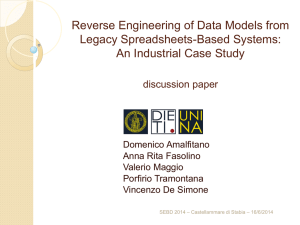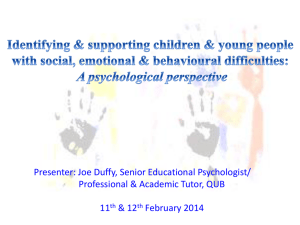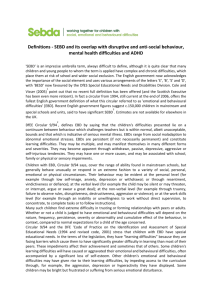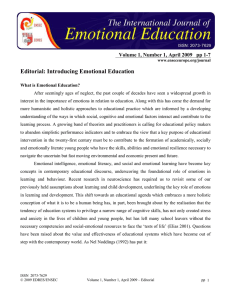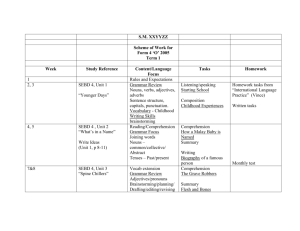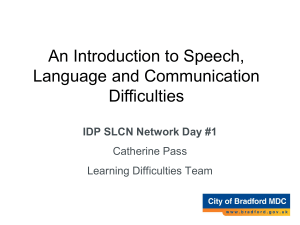Social, Emotional and Behavioural Difficulties in Young People:
advertisement
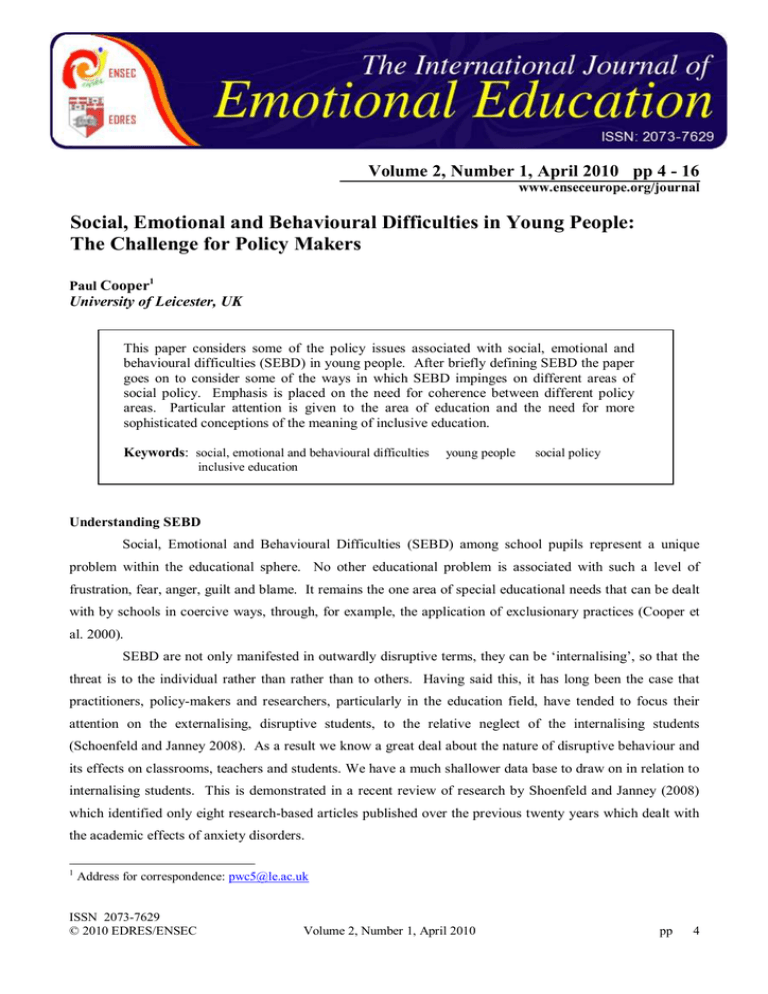
Volume 2, Number 1, April 2010 pp 4 - 16 www.enseceurope.org/journal Social, Emotional and Behavioural Difficulties in Young People: The Challenge for Policy Makers Paul Cooper1 University of Leicester, UK This paper considers some of the policy issues associated with social, emotional and behavioural difficulties (SEBD) in young people. After briefly defining SEBD the paper goes on to consider some of the ways in which SEBD impinges on different areas of social policy. Emphasis is placed on the need for coherence between different policy areas. Particular attention is given to the area of education and the need for more sophisticated conceptions of the meaning of inclusive education. Keywords: social, emotional and behavioural difficulties young people social policy inclusive education Understanding SEBD Social, Emotional and Behavioural Difficulties (SEBD) among school pupils represent a unique problem within the educational sphere. No other educational problem is associated with such a level of frustration, fear, anger, guilt and blame. It remains the one area of special educational needs that can be dealt with by schools in coercive ways, through, for example, the application of exclusionary practices (Cooper et al. 2000). SEBD are not only manifested in outwardly disruptive terms, they can be ‘internalising’, so that the threat is to the individual rather than rather than to others. Having said this, it has long been the case that practitioners, policy-makers and researchers, particularly in the education field, have tended to focus their attention on the externalising, disruptive students, to the relative neglect of the internalising students (Schoenfeld and Janney 2008). As a result we know a great deal about the nature of disruptive behaviour and its effects on classrooms, teachers and students. We have a much shallower data base to draw on in relation to internalising students. This is demonstrated in a recent review of research by Shoenfeld and Janney (2008) which identified only eight research-based articles published over the previous twenty years which dealt with the academic effects of anxiety disorders. 1 Address for correspondence: pwc5@le.ac.uk ISSN 2073-7629 © 2010 EDRES/ENSEC Volume 2, Number 1, April 2010 pp 4 These effects were found to include: • Academic impairment and relatively low levels of achievement among anxious children compared to children in the general population. • Teacher perceptions of academic difficulties among anxious students on a par with those of children with externalising difficulties. • Difficulties reported by anxious students in performing school based tasks including giving oral reports, concentration and completing homework tasks. • Anxious students being more likely to opt out of schooling owing to feelings of anxiety. There is a concomitant imbalance in the educational intervention literature between studies focusing on externalising as opposed to internalising students. In relation to both ‘acting-out’ and ‘acting-in’ problems, however, it is a source of concern that prevalence rates for mental health problems among school students appear to be increasing and have been for some time (Rutter and Smith 1995) . Whilst this phenomenon may be in part due to changes in diagnostic criteria and developments in assessment techniques and service delivery – factors which help determine what constitutes a ‘disorder’ and whether or not it is identified – this is unlikely to be the sole explanation (Fonagy et al. 2002). There is also evidence to suggest that widespread, culturally-based changes in the life experiences shared by young people, which have in turn led to changes in the very nature of social constructs such as ‘childhood’ and ‘adolescence’ and the ways in which adults relate to young people, have created a more SEBD-provocative world (e.g. Gibson-Klein 1996; Cunningham 2006; Layard and Dunn 2009). Recently, the UK’s British Medical Association (2006) estimated that 20% of young people experience a mental health problem at some point in their development, and 10% experience these problems to a level that represents a ‘clinically recognisable mental health disorder’. The range of problems includes: emotional disorders (such as anxieties, phobias and depression), self-harm and suicide, conduct disorders, hyperkinetic disorders/ADHD; autistic spectrum disorders, psychotic disorders, eating disorders, and substance and drug abuse. In the UK 20% of this group of young people are diagnosed with two or more disorders. What is the relationship between SEBD and social policy? There are no simple demarcation lines in social, emotional and behavioural difficulties. Delinquency among young people often overlaps with mental health problems, and both of these major areas seem to relate to adverse social circumstances in the communities where young people live and the schools they attend. The young person who exhibits mental health problems and/or social deviance (including delinquency) is likely to have difficulty in engaging in the school experience and, in the absence of effective intervention, is at great risk of experiencing a deterioration in their presenting difficulties as they move towards and through the adolescent years (Rutter and Smith 1995). ISSN 2073-7629 © 2010 EDRES/ENSEC Volume 2, Number 1, April 2010 pp 5 This means that SEBD often ripples across the whole field of social policy, involving social welfare, mental health, criminal justice and educational issues. This complexity is revealed in social learning models of development of SEBD (see Patterson et al. 1992) which show the way in which children who are born into families where there is significant social deprivation combined with dysfunctional parenting skills can be socialized to develop coercive social styles. Once in school, in the absence of corrective intervention, these young people become marginalised, and in adolescence form into delinquent sub-groups which foster the further development of anti-social behaviour. Upon leaving school, the now well honed anti-social coercive style creates barriers to employment and sustained, reciprocal relationships. In the absence of effective intervention, it is easy for these individuals to be drawn towards criminality and to develop substance abuse and mental health problems. These adults are then likely to become parents of a new generation of children with similar problems to their own. This cycle of disadvantage and difficulty is now well known and has become the target of multi-agency interventions of varying kinds which address different points in the cycle. Large scale early intervention programmes, such as Surestart in the UK (Glass 1999) are aimed at supporting the vulnerable parents and their young children in their homes and communities. Other multi agency-programmes set up to support children and young people of school age and their families include: Fast Track (CPPG 1999a/b; Bierman 2002, 2007) and Multi-Systemic Therapy (Henggeler et al. 1996). These incorporate social work, mental health, and educational agencies as well as community-focused criminal justice initiatives as required with the aim of breaking the cycle described above. The roles of the police service and juvenile courts can play a particularly important role in supporting behavioural change in community settings and thus preventing ‘graduation’ to adult criminality and custodial sentences (CJSNI 2007). A common and often highly rated component to these kinds of programmes is training in behaviour management and other parenting skills for parents, such as Parent Management Training (Lundahl et al. 2006; Kaminski et al. 2008) and the Incredible Years programme (Nixon 2002; Weisz 2004; Eyberg et al. 2008). There is strong evidence to suggest that targeted multi-agency programmes of these types have been found to be highly effective in supporting vulnerable families and their children in ways which lead to improved social and emotional functioning and positive engagement in education. This is, in turn, a major factor in breaking the cycle of disadvantage and disaffection. In considering the mechanics of how SEBD develops and can be addressed, it is important to pay some attention to the broader social and cultural backdrop against which it takes place. It seems reasonable to assume that very few parents set out with the intention of raising disaffected and unhappy children. Neither do the vast majority of teachers in schools wilfully seek to exacerbate the difficulties that their most vulnerable students present with. On the contrary, it seems reasonable to argue that given the choice, the overwhelming majority of parents and teachers want to perform their respective roles in ways which succeed in benefitting the children in their care. But if this is so, why do these problems persist? It was claimed in an earlier section of this paper that we live in a SEBD-provocative world. The ISSN 2073-7629 © 2010 EDRES/ENSEC Volume 2, Number 1, April 2010 pp 6 evidence behind this claim suggests that the prevalence of SEBD among our young people is, to a significant degree, a reflection of a maladjusted culture. To put it another way, societies beget the children they deserve. This point is brought home by the observation that increasing national prosperity seems, in many cultures, to equate with a decline in social and mental wellbeing of children and young people (Rutter and Smith 1995; Gibson-Cline 1996; James 2007, 2008; Layard and Dunn 2009). Layard and Dunn (2009) cite UNICEF st research evidence which shows that 21 century children in two of the richest countries in the world (the UK and USA) exhibit rising levels of emotional stress and behavioural disturbance that appear to coincide with increasing problems in the family, peer group and school settings. Furthermore, it is shown that children’s physical health is declining, particularly in relation to obesity, and the poverty-gap is widening, with the numbers of children living in economically deprived households being higher in the USA and UK than in other, often poorer western countries. The observation that the richer societies become, the relatively poorer some of their inhabitants become, seems at first to be counter-intuitive. Explanations for this state of affairs highlight the relationship between economic prosperity and individualism. In particular, it is claimed that the shift away from collectivist values which emphasise social responsibility and the role of the individual within the group, and the move towards individualism, which locates self actualisation as the pinnacle of human achievement, have led to serious problems for children and young people. Layard and Dunn (2009, 6) cite the ‘the individual pursuit of private interest and success’, which they see reflected to an excessive degree in US and British cultures, as major causes of problems which contribute to the social, emotional and behavioural difficulties experienced by children. They see these pursuits reflected in: … high [levels of] family break up, teenage unkindness, unprincipled advertising, too much competition in education and […] our acceptance of income inequality. (Layard and Dunn 2009, 6) The popular psychologist, Oliver James (2007, 2008) has coined the term ‘affluenza’ to describe this excessive individualism. ‘Affluenza’ is analogous to a disease, the symptoms of which are: an obsessive, but hopeless pursuit of fulfilment through rampant materialism and the urge to economic consumption and display. He argues that ‘affluenza’ distorts values to the extent that human qualities, such as empathy, kindness and love for others, become sidelined. In their place is an unhealthy concern with the superficial and the ephemeral. He argues that there is a direct relationship between this distortion of basic human needs and the rising tide of mental health problems throughout the developed world. In the context of the current paper it suffices to say that the pressures of individualism promote social isolation, which can easily translate into disaffection and alienation, especially among those labelled as being unlikely to make a significant contribution to the pursuit of culturally defined goals. As a result, the very practice of parenting may be defined as, on the one hand, a short term route to albeit minimal but actual economic advantage (e.g. by enabling access to social welfare benefits), whilst at the same time creating an ISSN 2073-7629 © 2010 EDRES/ENSEC Volume 2, Number 1, April 2010 pp 7 impediment to further economic advancement (e.g. access to employment opportunities). In these cultural circumstances, we have to acknowledge the possibility that parents and teachers may, albeit unconsciously, come to see themselves as being in competition with the children in their care. As a result, an ever growing gulf between the adult and the childhood/adolescent worlds seems to be developing (Gibson-Klein 1996; Cunningham 2006; Layard and Dunn 2009). It is cultural forces such as these in which SEBD is embedded and which have a major influence on the promotion of SEBD in all their forms. It is for this reason that the focus now shifts to the pivotally important area of education. For whilst it is certainly true that ‘education cannot compensate for society’ (Bernstein 1970), it is clear that education can contribute to the ability of individuals to navigate their way through the society that they inhabit. SEBD and Education It is certainly the case that a state education system, by definition, is created in the image of the society that it serves; even if this image is one which the society itself abhors. In this sense the education system never lies; it is a mirror to its society. As a result, twenty-first century schools in the UK and USA tend to reflect the rampant and competitive individualism of the wider culture, in which personal worth is measured in relation to the accumulation of grades and credentials. In this way education seems to have become increasingly cast in the role of servant to the economy, with the task of preparing the next generation of workers and tax payers. The crude instrumentalism of this approach places enormous pressure on teachers and their students to perform in relation to a narrow set of outcome indicators. Furthermore, they are required to operate in a situation marked by social and cultural inequalities which have a profound influence on the likelihood of success for different groups. It is argued, therefore, that there are systemic features inherent in certain education systems which exacerbate and even promote the development of SEBD. Modern interventions for SEBD are built on our developing understandings of the workings of these systemic forces. A brief discussion of such interventions will now be presented followed by a consideration of desirable policy developments. The evolution of educational understandings and approaches to SEBD In the 1960s and 70s emphasis was placed on exploring the power of the educational context to socially construct deviant identities among students from low socio-economic status (SES) backgrounds and vulnerable minority group. This theme is well illustrated in the sociological and educational research literature dealing with labelling theory and the self-fulfilling prophecy (Hargreaves, 1967; Rosenthal and Jacobson 1968; Hargreaves et al. 1975). Researchers in the USA (Silberman 1971; Bowles and Gintis 1976) and in the UK (Sharp and Green 1975; Willis 1977) revealed how the cultural lives of schools often reflect and reproduce tensions and inequalities in the wider society, leading to disenchantment and disengagement from ISSN 2073-7629 © 2010 EDRES/ENSEC Volume 2, Number 1, April 2010 pp 8 education among students from certain sections of society, such as lower SES groups and ethnic minorities (Coard 1971; Willis 1977). This led to a shift in emphasis in policy approaches in the USA and the UK, away from individualised, medicalised, within-child approaches to understanding and dealing with SEBD within more socially-oriented approaches which highlighted the impact of negative social experience on the development of SEBD and juvenile delinquency. In educational terms, this policy shift was reflected in efforts to improve equality of opportunity in education. In the UK this was illustrated in the widespread abandonment of selection by ability at the age of eleven and the introduction of comprehensive secondary schools. In the USA, large-scale statewide and community-based early interventions were pioneered, combining an aggressive approach to tackling poverty and unemployment with compensatory education programmes (e.g. Operation Headstart). The recently developed Sure Start in the UK offers a similar approach. Urban regeneration initiatives, such the UK government’s New Deal programme are reflective of this recognition of the relationship between poor living conditions, economic hardship and social and educational engagement. New Deal targeted areas of severe social deprivation with the injection of funds to improve the physical infrastructure, including the public-owned housing stock, community facilities and educational provision. It has been argued that this concoction, at its most negative, results in the development of an ‘underclass’ operating outside the boundaries of mainstream civil society to the detriment of both the wider society and themselves (MacDonald 1997). This construct provides a useful metaphor for understanding the experience of marginalisation, helplessness and despair experienced by people who find themselves cut off from the comforts and rewards that come with relative educational success, stable employment and membership of an aspirational community. This is particularly resonant in educational research studies which have repeatedly revealed that highly stratified educational systems often provoke the development of anti-social and anti-school sub-cultures among those who find themselves at the lowest strata (Hargreaves 1967; Cefai et al. 2008). A further dimension of the shift towards institutional interventions aimed at preventing educational failure and disaffection can be found in the school effectiveness (Reynolds and Sullivan 1979; Rutter et al. 1979; Purkey and Smith 1984; Mortimore et al. 1988; Smith and Tomlinson 1989) and school improvement literature (e.g Fullan 1992). This research endeavour is rooted in the unremarkable, but potent, recognition of the fact that the quality of a school makes a difference to pupil academic attainment. The accumulated research on school effectiveness produced a range of characteristics which appeared to differentiate between high and low performing schools (in terms of students' behaviour, attendance and attainment) with demographically-similar profiles. Core characteristics included: consultative approaches by school leaders; a curriculum tailored to pupils’ needs coupled with high expectations; positive teacher-pupil relationships and preventive rather than remedial approaches to behavioural problems and pastoral needs (Mortimore 1998). More recently it has been argued that one of the most important protective factors against problems of disaffection and delinquency is ‘attachment to schooling’ (Smith 2006). This can be defined in terms of the ISSN 2073-7629 © 2010 EDRES/ENSEC Volume 2, Number 1, April 2010 pp 9 degree of emotional commitment towards and positive social and academic engagement with schooling felt by students. Students who have a strong attachment to school, believe that success in school is in itself rewarding and will lead to significant rewards in later life. Weak attachment to school is characterized by indifference or hostility towards teachers and skepticism about the value of schooling. This perspective can be, in turn, linked with the concept of social and emotional resilience (e.g. Cefai 2008), which is concerned with inner resources that individuals have for dealing with social and emotional challenges. It is argued that schools can play a major role in promoting the development of such resources through the creation of caring, student centered educational environments emphasising the importance of emotionally supportive staff-student relationships and school systems which acknowledge the social and emotional underpinnings of the learning process. In addition to the above, there is a growing body of empirically based literature which reports on the effectiveness of specific intervention approaches and programmes aimed at preventing and remediating SEBD in schools (see Cooper and Jacobs 2010, for a review). These include behavioural and cognitive behavioural approaches that can be implemented by individual teachers, peer-cooperation programmes (Cowie et al. 2008) as well as whole school approaches, such as the School Wide Positive Behaviour Support (Vaughn 2006.) and FRIENDS programme (Barrett et al. 1999). There are also alternative or adjunct interventions which take place outside of mainstream classrooms and sometimes outside of mainstream schools, such as Nurture Groups (Cooper and Tiknaz 2007), and Career Academies (Kemple and Wilner 2008). Evidence shows that interventions such as these can be extremely effective in improving the quality teacher-student interactions and in promoting the positive development and the acquisition of social and emotional competencies among students. SEBD and inclusive education Contemporary understandings of socially aware approaches to education tend to be accompanied by a scepticism towards ‘non- mainstream’ approaches to SEN and an emphasis on ‘inclusive’ education (e.g Sebba and Sachdev 1997; Skidmore 2004). Unfortunately, there is often a wide gap between the aspirations towards inclusive education and practice. Curcic (2009) provides evidence from a review of inclusive practice in eighteen countries that adds to this bleak picture, prefacing the article with the following statement: In spite of a number of legislative moves, inclusive education has been surrounded by debates for various reasons. First, what is declared in legislation is not necessarily adequately implemented in practice […], or evenly within the borders of one country […]. Second, some debates centre on the very nature of inclusion […]. Researchers do not uniformly agree on what, in fact, constitutes inclusive practices. (Curcic 2009, 517) Recent research in the UK has highlighted some serious flaws in inclusive practice. This is noted by Shevlin et al. (2008, 143), who, with reference to OFSTED reports, find that: despite certain progress (towards inclusion) certain seemingly intractable difficulties remain as barriers to the realization of the inclusion strategy. ISSN 2073-7629 © 2010 EDRES/ENSEC Volume 2, Number 1, April 2010 pp 10 They highlight the point that students with SEBD are the most difficult to accommodate in mainstream schools because of the impact of such students on the wider community of students. MacBeath et al. (2006) report on a study they carried out in 20 English schools (10 first, middle and primary; 9 secondary and 2 special). They found a disastrous confection of ‘good intentions’, inadequate staff training and resources, and competing agendas which, they argue, contribute to a rising tide of social, emotional and behavioural difficulties which, in turn, create additional demands that school staff are illequipped to meet. The result is an unsatisfactory educational experience for staff and pupils in general. More recently, Blatchford et al. (2009) report on a large scale study of the impact of Teaching Assistants (TA) on attainment levels of students with SEN. They found that the more TA time students received, the lower their level of attainment. The authors express: concerns about [Teaching Assistants’] lack of preparedness, the way pupils can be separated from the teacher and the curriculum as a result of being supported by support staff, and the associations with academic progress. (Blatchford et al. 2009, 9) Given that TAs and other similar forms of in-class support personnel are often a central feature of inclusive education provision, it is disturbing to see these findings. These studies point to the dangers, identified by MacBeath et al. (2006), of basing educational provision on a commitment to an untested ideology. The irony of the situation identified by Blatchford and colleagues is the exclusionary and disabling effect of the very provision that is intended to promote inclusion. This also highlights the misleading nature of using the number of special school closures and the presence of students with SEN on the rolls of mainstream schools, as indices of inclusion. It points to the potential wisdom of maintaining a mixed-economy of mainstream and non-mainstream provision for children and young people with SEBD, the pattern found in most developed countries. However, one effect of the ideological aspect of the inclusion agenda is a tendency to marginalise and denigrate special provision (O’Keefe 2004; Shevlin et al. 2008). Conclusion: Implications for policy and intervention In relation to the broad social policy arena, it is clear that the social and emotional characteristics of children are influenced to a significant degree by their early, pre-school life experience. The support structures that are in place for young children and their parents can play a vital role in helping children to get the best out of the school experience. The quality of living conditions, employment opportunities, the accessibility of welfare support, and the availability of good quality health care provision, are fundamental in this regard. When things go wrong and children experience SEBD, it is important that interventions are implemented which are contiguous with these basic support structures. Where SEBD occur, they most often reflect a deficiency that requires rectification. This deficiency may reside in the environment of the child, in relation to influences in the family, neighbourhood peer group or school, and it may be influenced by factors ISSN 2073-7629 © 2010 EDRES/ENSEC Volume 2, Number 1, April 2010 pp 11 internal to the child, such as cognitive distortions and/or deficits, and biological predisposition. In some cases, influences from all of these sources may be at work. In any event, the emphasis needs to be directed at promoting the positive social engagement of children and young people who experience difficulties. Of particular concern in this area is the need for a balanced approach to intervention. It would be naïve and irresponsible to conclude that there are no circumstances in which individuals, including children, should be removed from their communities and placed in secure provision for the protection of themselves and others. Whether we like it or not, it is unlikely that we have seen the last of the children and adolescents who knowingly harm others and even commit murder. It is important however, that we recognise that there are often important commonalities shared by individuals who commit the worst offences against society and those who experience more common SEBD. Chief among these commonalities is a sense of detachment and sometimes alienation from the social and emotional world of the majority of their peers. This suggests that the main remedy, when such problems arise, should be aimed at healing this detachment and/or alienation. It follows therefore, that interventions must focus on the promotion of social and emotional competence. Immediate impulses towards coercive and exclusionary interventions will need to be resisted, simply because they are likely to reinforce the very problems they purport to address. This does not mean that the agencies which are traditionally associated with coercion and exclusion, such as the criminal justice system and psychiatric medicine, should be assumed to be part of the problem rather than part of the solution. Restorative justice programmes, for instance, seek to deal with criminal offences in ways which seek to repair ‘the relationship between the offender, the victim, and the community at large’ (CJSNI 2007, 1). Similarly, psychotherapeutic interventions can aid an individual’s ability to engage more effectively with their own emotions and aid their abilities to engage with others in pro-social ways (Nathan and Goreham 2002). Psychotropic medication can also aid these processes when used in the context of a multimodal intervention programme (Barkley 1992). The foregoing reinforces the core theme that policy responses to SEBD in young people must focus on the fulfilment of individual needs, and underlines the central role of education. This paper has been in part a plea for a rational and dispassionate look at the ways in which the inclusive education construct affects teachers and students in the real world and how this impacts on SEBD. It has underlined that diverse educational needs require diverse intervention and provision with an emphasis on parity of esteem. Positive social, emotional and educational engagement, are the goals of educational intervention for all students, and such engagement might take place in any one of a number of different educational settings. Educational placements should therefore be based on decisions about where opportunities for such engagement can be found, rather than on where some people think they ought to be found. This argument may be seen as a challenge to some approaches to inclusive education which assume a concordance between so-called mainstream schools and the mainstream of society (e.g.Booth and Ainscow 1997). What is exactly meant by the term ‘mainstream’ in either context is unclear. School systems, like societies, tend to be stratified in complex ways. In fact (with reference to an earlier section of this paper), one of the ways in which a society ISSN 2073-7629 © 2010 EDRES/ENSEC Volume 2, Number 1, April 2010 pp 12 might reproduce its social inequalities is by claiming that its schools share a common (e.g. ’mainstream’) status whereby inequalities in outcomes can only be attributed to the quality of the subject teaching skills of their staff. In conclusion it has to be stated that children and adolescents with SEBD are the casualties of dysfunctional societies. They deserve policy and intervention responses which acknowledge this reality. Only when specific attention is given to their particular needs will there be a significant measurable result in terms of this problem. References Barkley, R. 1992. ADHD: A Handbook for Assessment and Treatment. New York: Aronson Barrett, P.M., Lowry-Webster, H. and Turner, C.M. 1999. FRIENDS for children group leader manual. Brisbane: Australian Academic Press. Bernstein, B. 1970. Education cannot compensate for society. New Society, 15, no. 387: 344-347 Bierman, K.L., Coie, J.D., Dodge, K.A., Foster, E.M., Greenberg, M.T., Lochman, J.E., McMahon, R.J. and Pinderhughes, E.E. 2002. The implementation of the Fast Track program: An example of a large-scale prevention science efficacy trial. Journal of Abnormal Child Psychology, 30, no. 1: 1-17. Bierman, K.L., Coie, J.D., Dodge, K.A., Foster, E.M., Greenberg, M.T., Lochman, J.E., McMahon, R.J. and Pinderhughes, E.E.. 2007. Fast track randomized controlled trial to prevent externalizing psychiatric disorders: Findings from grades 3 to 9. Journal of the American Academy of Child and Adolescent Psychiatry, 46, no.10: 1250-1262. Blatchford, P., Bassett, P., Brown, P., Koutsoubou, M., Russell, A., Webster, R. and Rubie-Davies, C. 2009. The Deployment and Impact of Support Staff in Schools. London: DCSF. Booth, T. and Ainscow, M. 1997. From Them to Us. London: Routledge. Bowles, S. and Gintis, H. 1976. Schooling in Capitalist America. London: Routledge and Kegan Paul. British Medical Association. 2006. Child and adolescent mental health – a guide for healthcare professionals. London: BMA. Cefai, C. 2008. Promoting resilience in the classroom. A guide to developing pupils’ emotional and cognitive skills. London: Jessica Kingsley Publishers. Cefai, C., Cooper, P. and Camilleri, L. (2008). Engagement Time. A national study of social, emotional and behaviour difficulties in Maltese schools. Malta: European Centre for Educational Resilience and Socio-Emotional Health, University of Malta. CJSNI (Criminal Justice System: Northern Ireland). 2007. Protocol for Community Based Restorative Justice Schemes. Northern Ireland: CJSNI Coard, B. 1971. How the West Indian Child is Made Educationally Sub Normal by the British School System. London: New Beacon Books. Cooper, P and Jacobs, B. 2010 forthcoming. From Inclusion to Engagement. London: Wiley ISSN 2073-7629 © 2010 EDRES/ENSEC Volume 2, Number 1, April 2010 pp 13 Cooper, P. and Tiknaz, Y. 2007. Nurture Groups at Home and In School: Connecting with Children with Social, Emotional and Behavioural Difficulties. London: Jessica Kingsley Publishers. Cooper, P, Drummond, M, Hart, S, Mclaughlan and Lovey, S. 2000. Positive Alternatives to Exclusion. London: Routledge Cowie, H., Hutson, N., Jennifer, D. and Myers, C.A. 2008. Taking stock of violence in U.K. schools: Risk, regulation, and responsibility. Education and Urban Society, 40, no. 4: 494505. CPPRG, 1999b. Initial impact of the fast track prevention trial for conduct problems: II. Classroom effects. Journal of consulting and clinical psychology, 67, no. 5: 648-657. CPPRG, 1999a. Initial impact of the fast track prevention trial for conduct problems: I. The highrisk sample. Journal of consulting and clinical psychology, 67, no. 5: 631-647. Cunningham, H. (2006) The Invention of Childhood. London: BBC Books Curcic, S. 2009. Inclusion in the PK-12: and international perspective. International Journal of Inclusive Education, 13, no. 5: 517-538 Eyberg, S.M., Nelson, M.M. and Boggs, S.R. 2008. Evidence-based psychosocial treatments for children and adolescents with disruptive behavior. Journal of Clinical Child and Adolescent Psychology, 37, 1: 215-237 Fonagy, P., Target, M., Cottrell, D., Phillips, J. and Kurtz Z. 2002. What Works for Whom? A Critical Review of Treatments for Children and Adolescents. New York: Guilford. Fullan, M. 1992. Successful School Improvement. Milton Keynes: Open University Press Gibson-Klein, J. 1996. Adolescence: from crisis to coping. Oxford: Butterworth-Heinemann. In J.GibsonKlein ed. Adolescence: From Crisis to Coping. Oxford: Butterworth-Heinnemann Glass, N. 1999. Sure Start: The Development of an Early Intervention Programme for Young Children in the United Kingdom. Children & Society, 13, no.4: 257-264. Hargreaves, D., 1967. Social Relations in a Secondary School. London: Routledge. Hargreaves, D., Hester, S. and Mellor, F. 1975. Deviance in Classrooms. London: Routledge Henggeler, S.W., Cunningham, P.B., Pickrel, S.G., Schoenwald, S.K. and Brondino, M.J. 996. Multisystemic therapy: An effective violence prevention approach for serious juvenile offenders. Journal of Adolescence,19, no. 1: 47-61. James, O. 2007. Affluenza. London: Vermilion James, O. 2008. The Selfish Capitalist. London: Vermilion Kaminski, J.W., Valle, L.A., Filene, J.H. and Boyle, C.L. 2008. A meta analytic review of components associated with Program Training Progress Effectiveness. Journal of abnormal Child Psychology, 36: 567-589. Kemple, J. and Wilner, C.J. 2008. Career Academies: Long-term impact on Labor Market outcomes, Educational Attainment and Transitions into Adulthood. New York: Manpower Demonstration Research Corporation. ISSN 2073-7629 © 2010 EDRES/ENSEC Volume 2, Number 1, April 2010 pp 14 Layard, R and Dunn, J. 2009. A Good Childhood, London: Penguin Lundahl, B., Risser, H.J. and Lovejoy, M.C. 2006. A meta-analysis of parent training: Moderators and followup effects. Clinical Psychology Review, 26, no 1: 86-104. MacBeath, J., Galton, M., Stewart, S., MacBeath, A. and Page, C. 2006. The Costs of Inclusion. Cambridge: University of Cambridge Faculty of Education MacDonald, R., ed. 1997. Youth, the Underclass, and Social Exclusion. London: Routledge Mortimore, P., Sammons, L., Stoll, C. and Ecob, R. 1988. School Matters. London: Open Books. Mortimore, P. 1998. The Road to Improvement. Reflections on School Effectiveness. Lisse, Netherlands: Swets and Zeitlinger Nathan, P. and Gorham, J. 2002. A Guide to Treatments that Work. Oxford: Oxford University Press Nixon, R.D.V. 2002. Treatment of behavior problems in preschoolers: A review of parent training programs. Clinical Psychology Review, 22, no. 4: 525-546 O'Keefe, P. 2004. The Special School in an age of inclusion. Journal of Special Needs Education in Ireland, 18, no.1: 3-15. Patterson, G., Reid, J and Dishion, T. 1992. Anti-Social Boys: Vol 4. Eugene OR: Castalia. Purkey, S. and Smith, M. 1984. Effective Schools: a review. Elementary School Journal, 83, no. 4: 427-453 Reynolds, D. and Sullivan, M. 1979. Bringing schools back. In: L. Barton and R. Meighan, eds. Schools, Pupils and Deviance. Driffield: Nafferton Rosenthal, R. and Jacobson, L. 1968. Pygmalion in the Classroom. New York: Holt, Reinhart and Winston. Rutter, M., Maughan, B., Mortimore, P. and Ouston, J. 1979. Fifteen Thousand Hours: Secondary schools and their effects on children. London: Open Books Rutter, M and Smith, D.1995. Psychosocial Disorders in Young People. Chichester: Wiley Schoenfeld, N and Janney, D. 2008. Identification and treatment of anxiety in students with emotional or behavioral disorders: a review of the literature. Education and Treatment of Children, 31, no. 4: 583610 Sebba, J. and Sachdev, D. 1997. What Works in Inclusive Education. Basingstoke: Barnados Sharp, A and Green, R. 1975. Education and Social Control, London: RKP Shevlin, M., Kenny, M. and Loxley, A. 2008. A Time of Transition: Exploring Special Educational Provision in the Republic of Ireland. Journal of Research in Special Educational Needs, 8, no. 3: 141-152. Silberman, C. 1971. Crisis in the Classroom. New York: Random House. Skidmore, D., 2004. Inclusion. Milton Keynes: Open University Press Smith, D. 2006. School Experience and Delinquency at Ages 13 to 16. Edinburgh: University of Edinburgh, Centre for Law and Society. ISSN 2073-7629 © 2010 EDRES/ENSEC Volume 2, Number 1, April 2010 pp 15 Smith, D. and Tomlinson, S. 1989. The School Effect: A study of multi-racial Comprehensives. London: Routledge Vaughn, B.J. 2006. The Wave of SWPBS: Who Is Left behind? Research and Practice for Persons with Severe Disabilities, 31, no. 1: 66-69. Weisz, J.R., Hawley, K.M. and Jensen Doss, A. 2004. Empirically tested psychotherapies for youth internalizing and externalizing problems and disorders. Child and Adolescent Psychiatric Clinics of North America, 13, no.4: 729-815. Willis, P. 1977. Learning to Labour: How Working Class Kids Get Working Class Jobs. London: Saxon ISSN 2073-7629 © 2010 EDRES/ENSEC Volume 2, Number 1, April 2010 pp 16

